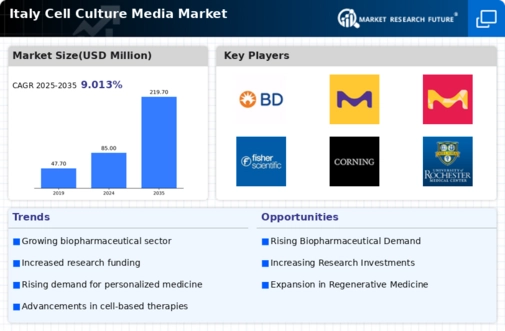Expansion of Research Institutions
Italy is home to numerous research institutions and universities that are heavily involved in life sciences and biotechnology. The expansion of these institutions is likely to drive the cell culture-media market, as they require advanced media for various research applications. In 2025, it is estimated that research funding in Italy will reach €1 billion, with a significant portion allocated to cell culture studies. This growth in research activities necessitates a diverse range of cell culture media to support different cell types and experimental conditions. Consequently, the cell culture-media market is poised to benefit from the increasing demand for tailored media solutions that cater to the specific needs of these research institutions.
Increasing Investment in Biotechnology
The cell culture-media market in Italy is experiencing a surge in investment, particularly from both public and private sectors. This influx of capital is primarily directed towards biotechnology firms that are developing innovative therapies and products. In 2025, the Italian government allocated approximately €500 million to support biopharmaceutical research, which is expected to enhance the demand for specialized cell culture media. As biotechnology continues to evolve, the need for high-quality media formulations that support cell growth and productivity becomes increasingly critical. This trend indicates a robust growth trajectory for the cell culture-media market, as companies strive to meet the rising expectations of researchers and manufacturers in the biopharmaceutical sector.
Rising Adoption of Personalized Medicine
The trend towards personalized medicine in Italy is influencing the cell culture-media market significantly. As healthcare providers and researchers focus on developing treatments tailored to individual patient profiles, the demand for specialized cell culture media is expected to rise. In 2025, the personalized medicine market in Italy is projected to grow by 15%, which will likely increase the need for media that can support the cultivation of patient-derived cells. This shift towards personalized approaches in medicine necessitates innovative media formulations that can accommodate the unique requirements of various cell types. Thus, the cell culture-media market is likely to see substantial growth as it adapts to the evolving landscape of personalized healthcare.
Regulatory Support for Biopharmaceutical Development
Regulatory support for biopharmaceutical development in Italy is fostering a conducive environment for the cell culture-media market. The Italian Medicines Agency (AIFA) has streamlined approval processes for biopharmaceutical products, encouraging companies to invest in research and development. This regulatory framework is expected to enhance the demand for cell culture media, as biopharmaceutical companies require reliable and effective media for their production processes. In 2025, it is anticipated that the biopharmaceutical sector will grow by 10%, further driving the need for specialized media formulations. The supportive regulatory landscape is likely to create opportunities for growth within the cell culture-media market, as companies seek to comply with stringent quality standards while developing innovative therapies.
Technological Advancements in Cell Culture Techniques
Technological advancements in cell culture techniques are playing a pivotal role in shaping the cell culture-media market in Italy. Innovations such as 3D cell culture and bioreactor technologies are gaining traction, leading to a demand for specialized media that can support these advanced methodologies. In 2025, the market for 3D cell culture is expected to grow by 20%, indicating a shift in research practices. These advancements require media that can provide optimal conditions for cell growth and functionality, thereby driving the need for high-quality formulations. As researchers and companies adopt these new technologies, the cell culture-media market is likely to expand in response to the evolving requirements of modern cell culture practices.



















Leave a Comment